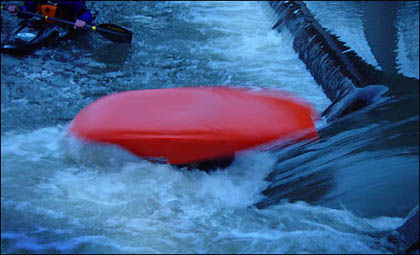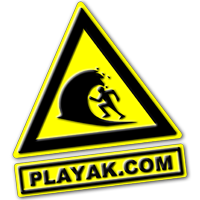[please login to make this ad block disappear]
Articles
Riot Air review, part 1

Ergonomics is the applied science of engineering things to interact with people in the most safe and efficient manner possible. The progression of kayak design is a study of human engineering and the ends we seek on the river. What design will allow the most while demanding the least? As planing hulls become more and more efficient, concessions to displacement hull speed become less and less relevant. Whitewater kayaking, as we know, has deep roots in slalom and has held displacement hull speed - a function of waterline length - in high regard for many many years. They were racing against the clock back in those days. But long boats are difficult to swap ends and spin because of the excess volume once needed to maintain hull speed. They demand larger river features and more powerful currents to operate as playboats - bad ergonomics. So the evolution of playboats has been the diminishment of overall length and volume without sacrificing speed on the wave. To this end we are now seeing swallow-tail sterns, "stingers" borrowed from surfboarding, wrap-around release edges and so forth and so on: anything that reduces drag to an absolute minimum. This has allowed the sport to progress beyond "spud boats" to the next generation of super short playboats: infra-short boats. The 6' Air 45 is part of what could be called the infra-short boats, the current shortest being the 5'9" Dagger FX. This is the last chapter in freestyle boat design as far as getting shorter goes, before the traditional K-1 sitting position gives way to C-1 saddles, a cross-legged sitting position or voluntary amputation surgery.
The Air 45 hull is based on the "tough but tender" Booster with a release edge, massive planing surface and Riot's famous hydro-glide "Water Waffle". The stern includes a wide arsenal of releasing/carving gadgetry - swallow-tail, stingers, channeling ridges and the now familiar fin boxes. It's volume distribution is short and slicey with most of its volume around the cockpit - ideal for the very small holes and pourovers which this first review will focus on.
SMALL HOLE PERFORMANCE
When you get down to 6' and 45 gallons of volume, the performance of the boat will be highly dependant on the physical dimensions of the paddler. So, this is going to be very subjective to my dimensions - 6'0" tall, 33" inseam, 162 pounds of pure corn-fed Iowa beefcake. Holes are not my forté, but the ludicrous shortness and general slicability of the Air makes it feel almost like cheating to get ends in both flatwater and in the hole. While the stability of longer ends is definitely missing, the lack of any bounciness caused by superfluous volume makes the Air very easy to pause and control on end. Many of my rides terminated on a very steady stern stall washout of the hole. Turning the boat on the long axis such as in splitwheels, Orbits or Matrices (plural Matrix) is also easy - there's no boat to get in the way, you just turn it. The Air requires very little balancing to stay vertical, and I have to admit that my rides were about as vertical as I've ever gotten them. The slicey/shortness also adds up to almost no drag, so you get more control than you may know what to do with immediately.

Both of the Airs loop pretty well, but I have no idea how they will compare with more loop specific designs like the Air Head or Space Cadet in that regard.
The video of the spins is worth the download time. When I tried the Booster last season, I was very impressed with the looseness yet ease of paddling that the chines provided. The Air is much the same - a very stable platform to work from, with good edges and the added advantage of being extremely short. I think the video I've included in the review is a pretty good demonstration of just how stable the Air can be. If you are the kind of paddler who drives with your knees, you will appreciate this. In flat mode, the Air is very loose along all angles to the current - surf, sidesurf, backsurf.
DOWNSIDES
The shortness does have it's drawbacks, but most of those will manifest in larger holes where it takes more length to reach the green. In displacement mode, the Air is slow and doesn't track at all. Nothing new there, all of the infra-short boats are the same in that respect. I am going to take issue with the outfitting again - because it is attached to the seat with a strongback, the backband wants to wedge you out of the boat, which is not good. With my 33" inseam, I don't use the thigh straps because my feet are crammed up into the very front of the bow, but oddly enough they still feel more comfortable than the Disco.
SUMMARY
I was a lot more impressed than I thought I would be. The design curve is leveling off for playboats, and it's tempting to assume that they all perform basically the same, but the Air gave me more fun than I was expecting. The Air shows that playboating is finally reaching much more human dimensions, and opening moves to smaller rivers and paddlers. It efficiently and effectively puts the boater in total control of the boat; that is to say that the Air has outstanding ergonomics.
Thumbs up. Way up.
| IMAGE | SIZE |
| Stern view on cartwheel, blurry | 40 K |
| In the pourouver | 82 K |
| Wheelin' | 40 K |
| VIDEO (turn down the volume) | SIZE |
| Half a dozen (sorta) clean spins or something like that | 500 K |
| Ken hits 4 loops in a row | 360 K |




